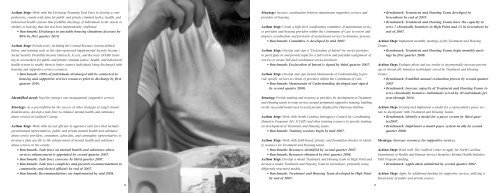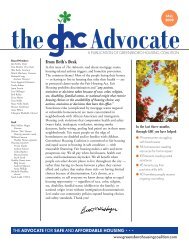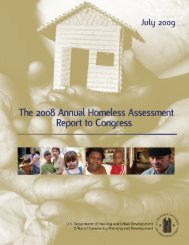Ten Year Plan to End Chronic Homelessness - Greensboro Housing ...
Ten Year Plan to End Chronic Homelessness - Greensboro Housing ...
Ten Year Plan to End Chronic Homelessness - Greensboro Housing ...
You also want an ePaper? Increase the reach of your titles
YUMPU automatically turns print PDFs into web optimized ePapers that Google loves.
The community cost of chronic homelessness: high usage of expensive<br />
services without achieving positive outcomes<br />
When chronically homeless persons continue <strong>to</strong> use crisis response<br />
resources over and over again, the costs can mount insidiously while no<br />
positive outcome is achieved. In Denver, police officers tracked the cost <strong>to</strong><br />
their community in services for one chronically homeless man and found<br />
that over a decade, he had cost the community more than $1 million. But<br />
the community’s investment in this man yielded no return; he died on<br />
the streets. One officer stated, “It cost us a million dollars <strong>to</strong> do nothing<br />
about Murray.” (This chronically homeless individual, dubbed “Million<br />
Dollar Murray” was the subject of a highly publicized New Yorker article by<br />
Malcolm Gladwell that highlighted the problems and costs of chronic<br />
homelessness.)<br />
A qualitative survey done in July of 2006 found that 43% of the homeless<br />
persons surveyed in Guilford County had been discharged from the jail<br />
system, mental health system, or a health care system within 30 days of<br />
their current episode of homelessness (Homeless Prevention Coalition of<br />
Guilford County, 2006). There were 171 individuals who had been involved<br />
in the criminal justice system and in jail, 50 who had needed the assistance<br />
of the public mental health system, and 88 who had been hospitalized.<br />
But for each of these individuals, their outcome ultimately did not<br />
improve; at the time of the survey they were again homeless and at risk.<br />
until finally receiving a diagnosis of MS. Now using medication and therapy,<br />
he is essentially as stable as possible but continues <strong>to</strong> receive medical<br />
services and <strong>to</strong> participate in out-patient substance abuse counseling.<br />
From 2001 <strong>to</strong> 2005, while homeless, he utilized approximately $180,520<br />
in services or an average of $36,104 annually; since being housed in 2006,<br />
he has used an annual amount of $34,688.<br />
Reducing and ending chronic homelessness improves a community’s quality<br />
of life and social order and is also a more fiscally responsible approach<br />
than simply allowing the problem <strong>to</strong> persist. <strong>Homelessness</strong> is a crisis situation<br />
in which individuals often access expensive community resources<br />
without achieving outcomes that lead <strong>to</strong> stability in housing and health.<br />
The North Carolina Department of Health and Human Services has stated:<br />
Mitchell M.<br />
“Homeless individuals, in particular homeless individuals with behavioral<br />
health disorders, bounce between systems which provide extremely expensive<br />
short term care with negligible long term effect.”<br />
A 47 year old white male, Mitchell was honorably discharged from the<br />
military due <strong>to</strong> mental illness; he is a schizophrenic who self-medicated<br />
with substance abuse. He spent time in substance abuse and mental<br />
health treatment locally and at Dorothea Dix and John Umstead hospitals.<br />
Mitchell had lived on the streets and in the woods for 8 years prior <strong>to</strong><br />
being housed. A good carpenter, he had built himself a small shelter with<br />
a door on vacant city property. While on the streets, he was shot during a<br />
robbery in which he was the victim; he subsequently had surgery and<br />
underwent extensive rehabilitation on his shoulder and arm. After being<br />
housed and being compliant with medication for his schizophrenia, he<br />
lost the desire <strong>to</strong> abuse substances and is now stable. While homeless during<br />
2001 <strong>to</strong> 2004, he used services costing a <strong>to</strong>tal of $168,000, or an average<br />
annual cost of $42,000; after being housed, his average annual cost in<br />
services has been $25,603.<br />
An in-depth study of housing needs of Guilford Center clients done in<br />
2005 by the Technical Assistance Collaborative indicated that of those<br />
consumers served by Guilford Center ACT teams, Diversion Teams, and<br />
Community Support Teams, only 38% were in a permanent housing situation.<br />
The survey indicated that at least 28% were in unstable or unsafe situations<br />
and in need of permanent supportive housing (The Technical<br />
Assistance Collaborative, 2005.)<br />
In Guilford County, as in most communities, the cost of utilization of the<br />
criminal justice, health, and mental health systems far outweighs the cost<br />
of utilization of permanent supportive housing.<br />
Studies have shown that persons without stable housing have more health<br />
issues than those with housing; one third <strong>to</strong> one half of the homeless<br />
population has a chronic illness, compared <strong>to</strong> less than one fourth of the<br />
housed population (Zerger, 2002). Mortality rates for homeless person are<br />
three times higher than for housed persons of the same age (O’Connell,<br />
2005). Homeless persons have higher rates of hospitalization and emergency<br />
department use than the general population (O’Connell, 1999). A<br />
report prepared in 2006 by the New York Department of Homeless<br />
Services and Department of Health found that health disparities between<br />
the homeless population and the housed population were “huge.” For<br />
example, new HIV diagnoses among the homeless population were 16<br />
times higher than among the housed population.<br />
The cost per bed per night of the possible alternatives for homeless individuals<br />
is as follows:<br />
The <strong>Greensboro</strong> Police Department and High Point Police Departments<br />
tracked time spent on calls dealing with homeless individuals during<br />
2005. The High Point Police Department found an annual cost of $5,103<br />
in police time just dealing with calls at High Point’s two emergency shelters;<br />
the <strong>Greensboro</strong> Police Department found an annual cost of $156, 037<br />
for calls involving homeless individuals, or an amount of officer time<br />
equal <strong>to</strong> more than two full time police officers.<br />
Type of housing Cost/night Cost/night<br />
Range<br />
Median<br />
Emergency shelter $13 - 14 $13.50<br />
Transitional housing $18 - 59 $38.50<br />
Homeless persons also are more likely <strong>to</strong> use jails and prisons than housed<br />
individuals. Individuals who were homeless at the time of arrest are overrepresented<br />
in the prison population (Dit<strong>to</strong>n, 1999). Homeless populations<br />
have higher rates of former prisoners than the general population (Burt et<br />
al, 1999). The association between homelessness and imprisonment is<br />
bidirectional: imprisonment disrupts family and community contacts and<br />
decreases employment and housing prospects, while homelessness can<br />
increase the likelihood of arrest and imprisonment (Kushel et al, 2005).<br />
There are also linkages between imprisonment and severity of mental illness<br />
and substance abuse in homeless individuals (McGuire, 2004).<br />
Permanent supportive housing $26 – 47 $36.50<br />
Jail $70<br />
$70.00<br />
Case studies of eight chronically homeless individuals in Guilford County<br />
highlight the human and social costs of homelessness.<br />
Bob O.<br />
A 45 year old black male, he spent a great deal of time in jail and in the<br />
hospital prior <strong>to</strong> 1999 (before the study period began); he attempted suicide<br />
in 1999. In 2000 he suffered a broken leg and was hospitalized; he<br />
has been hospitalized and made Emergency Department visits numerous<br />
times since then, including one hospitalization for pneumonia. He has<br />
been HIV positive for 11 years. He has rarely used emergency shelter or<br />
other services voluntarily because he has difficulty in congregate situations.<br />
While homeless during 2001 through 2006, he utilized a <strong>to</strong>tal of<br />
$77,619 in services, or an annual average of $15,524; since being housed<br />
he has had an average annual cost of $16,670.<br />
Hospital (incl. behavioral health) $300 – 700 $500.00<br />
Jack R.<br />
*Note: cost of transitional and permanent supportive housing includes supportive<br />
services costs; emergency shelter, jail and hospital costs do not include any<br />
health care or supportive services costs.<br />
A 50 year old black male, Jack has now been diagnosed with latter stage<br />
Multiple Sclerosis (MS). Prior <strong>to</strong> being housed, he spent time in hospitals,<br />
emergency shelter, and jails and participated in substance abuse treatment,<br />
utilizing services locally, in Salisbury, and in Wins<strong>to</strong>n–Salem. He<br />
spent increasing amounts of time hospitalized for back and leg problems<br />
6<br />
7




